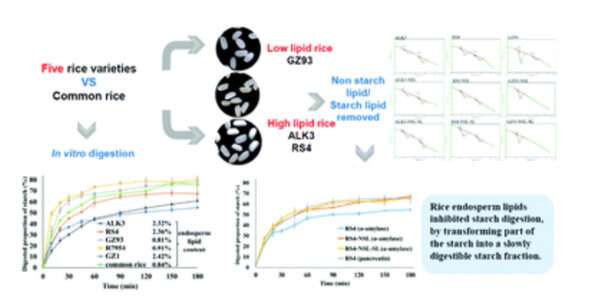Credit: Zhe Jiang University
According to the Healthy China Initiative, the incidence rate of diabetes is 12.8% in China, with about 150 million patients, and the incidence rate of dyslipidemia is 18.6%, with about 160 million patients. Common rice has a relatively high percentage of digestible starch and is therefore considered as a kind of food with a high glycemic index (GI). Breeding new varieties of rice rich in resistant starch or slowly digestible starch can meet the needs of "diabetes and obesity" patients and make people eating healthy.
On October 28, Prof. WU Dianxing at the Zhejiang University College of Agriculture & Biotechnology and Prof. Fogliano Vincenzo at Wageningen University & Research co-published an article entitled "Rice varieties with a high endosperm lipid content have reduced starch digestibility and increased γ-oryzanol bioaccessibility" in the journal Food & Function.
Lipids affect the taste and flavor of rice, which is one of the reasons for making cooked rice so tempting. Lipids play an inhibitory role in starch digestion, but the relevant mechanism remains unclear. Lipids in rice includes non-starch and starch kinds, with the former one usually higher than the latter one. In addition, γ-oryzanol as a bioactive compounds is especially abundant in rice compared to other cereals. γ-oryzanol is a plant-based cellular melanogenesis inhibitor, and is therefore an important ingredient of skin care products. γ-oryzanol is usually found in brown rice or rice bran, but rarely reported in white rice as common rice has an extremely low lipids content in endosperm. Wu and his colleagues obtained rice mutants with high resistant starch and high endosperm lipids from the parent R7954 using the gamma irradiation approach. This study revealed the slow digestion mechanism and high bioaccessibleγ-oryzanol content of high-lipid rice mutants, indicating the potential of a new "low-GI and skin-care" rice.
In their study, researchers investigated the digestion properties of rice varieties and found that the lipid content is positively correlated with the resistant starch content and negatively correlated with the digestion extent and the estimated glycemic index (eGI). After non-starch lipid was removed from selected high-lipid mutants (ALK3 and RS4), the digestion extent was significantly enhanced compared to native samples when digested by α-amylase, while this phenomenon was not observed in low-lipid rice (GZ93). "These results indicate that rice endosperm lipids inhibited starch digestion, by transforming part of the starch into a slowly digestible starch fraction," said Wu. "High-lipid mutants also have a higher total amount of, and more bioaccessible, γ-oryzanol than low-lipid varieties. Therefore, high-lipid white rice has great potential in designing functional rice-based foods, combining a relatively lower eGI and a high γ-oryzanol content."
More information: Yi Shen et al, Rice varieties with a high endosperm lipid content have reduced starch digestibility and increased γ-oryzanol bioaccessibility, Food & Function (2021). DOI: 10.1039/D1FO03039F
Provided by Zhe Jiang University





















